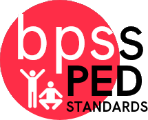PED-HS.S2.MC.01
|
High School (PED) Targeted Standards
Standard 2: Student applies knowledge of concepts, principles and tactics related to movement and performance.
(IMC) Cluster: Movement Concepts, Principles and Knowledge
PED-HS.S2.MC.01 Applies the terminology associated exercise and participation in selected lifetime activities, dance and rhythm, and fitness activities.
|
Student Learning Targets:
Student "I can" statements are embedded in Proficiency Scale
Proficiency Scale
| Score |
|
Description |
Sample Activity
|
| 4.0 |
In addition to Score 3.0, the student demonstrates in-depth inferences and applications regarding more complex material that go beyond end of instruction expectations.
- Applies a practice plan to improve performance for a self-selected skill (S2.H3.L2)
- Analyze and revise movement concepts (e.g., describes the speed/accuracy trade-off in throwing and striking skills) and principles (e.g., force, motion, rotation) to analyze and improve performance of self and/or others in self-selected skill in lifetime activities, dance and rhythm, and fitness activities. (S2. H2.L2)
|
- |
| |
3.5 |
In addition to Score 3.0 performance, the student demonstrates in-depth inferences and applications regarding the more complex content with partial success. |
| 3.0 |
“The Standard.” The student demonstrates no major errors or omissions regarding any of the information and processes that were end of instruction expectations.
- Applies the terminology associated exercise and participation in selected Lifetime activities, dance and rhythm and fitness activities (S2.H1.L1).
- Applies movement concepts (e.g., describes the speed/accuracy trade-off in throwing and striking skills) and principles (e.g., force, motion, rotation) to analyze and improve performance of self and/or others in self-selected skill in lifetime activities, dance and rhythm, and fitness activities. (S2. H2.L1)
- Demonstrate examples of social and dance forms. (e.g., ballet, modern, hip hop, tap). (S2.H4.L1)
|
Dance, Outdoor Rec, Fitness, Badminton, Softball, Golf, Racquetball, Pickleball, Curling, Softball, Eclipse Ball, Tennis Buka Ball, Basketball, Table Tennis, Minor Sports, Wallyball
|
| |
2.5 |
The student demonstrates no major errors or omissions regarding the simpler details and processes (Score 2.0 content) and partial knowledge of the more complex ideas and processes (Score 3.0 content). |
| 2.0 |
The student demonstrates no major errors or omissions regarding the simpler details and processes but exhibits major errors or omissions regarding the more complex ideas and processes (Score 3.0 content).
- Identify the terminology associated exercise and participation in selected Lifetime activities, dance and rhythm and fitness activities (S2.H1.L1)
- Identify movement concepts (e.g., describes the speed/accuracy trade-off in throwing and striking skills) and principles (e.g., force, motion, rotation) to analyze and improve performance of self and/or others in self-selected skill in lifetime activities, dance and rhythm, and fitness activities. (S2. H2.L1)
- Name examples of social and dance forms. (e.g., ballet, modern, hip hop, tap). (S2.H4.L1)
|
- |
| |
1.5 |
The student demonstrates partial knowledge of the simpler details and processes (Score 2.0 content) but exhibits major errors or omissions regarding the more complex ideas and procedures (Score 3.0 content). |
| 1.0 |
With help, the student demonstrates a partial understanding of some of the simpler details and processes (Score 2.0 content) and some of the more complex ideas and processes (Score 3.0 content). |
- |
| |
0.5 |
With help, the student demonstrates a partial understanding of some of the simpler details and processes (Score 2.0 content) but not the more complex ideas and processes (Score 3.0 content). |
| 0.0 |
Even with help, the student demonstrates no understanding or skill. |
- |
Resources
Websites
Vocabulary |

